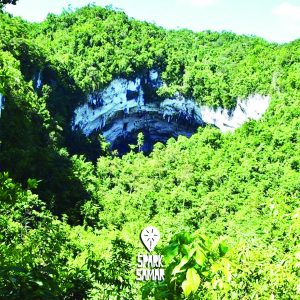
TACLOBAN CITY – The Samar Island Natural Park (SINP) located in the heart of Samar Island is finally on the “tentative list” of the United Nations Educational, Scientific and Cultural Organization (UNESCO) World Heritage Site.
The inclusion of SINP at the UNESCO World Heritage Site under the Natural Heritage Category was initiated in 2018 by Samar Governor Sharee Ann Tan and was supported by Northern Samar Governor Edwin Ongchuan, Eastern Samar Ben Evardone, the Department of Environment and Natural Resources and the Department of Tourism.
Samar province also partners with the University of Santo Tomas Graduate School – Center for Conservation of Cultural Property and Environment of the Tropics (USTGS-CCCPET) in conducting a workshop for capacitating the technical working of the three provinces.
“We are ecstatic to now be included in the tentative listing. A proud moment for all people in Samar,” Gov. Tan said in a statement.
In the document submitted by the province to the UNESCO Philippines committee, it states that SINP with an area of 300,000 hectares is home to the largest tract of relatively intact lowland forest in the Philippines and a rich population of dipterocarp species, home of endemic floral and faunal species deemed important from the point of view of conservation sciences.
Also within the park are four areas wherein the rich biodiversity and high rate of endemism converge; these are Sohoton Natural Bridge National Park, Calbiga Caves Protected Landscape, Jicontol Natural Park, and Taft Forest Philippine Eagle Wildlife Sanctuary.
“DOT8 is privilege to be part of this journey. Backed with a very extensive dossier, we pray that in time, we will have Eastern Visayas first UNESCO World Heritage Site,” Karina Rosa Tiopes, the regional director of the Department of Tourism, said.
She added that to be included on the list, sites must be of outstanding universal value and meet one out of 10 selection criteria.
“We are proud to say that SINP not only met not just one but three of these criteria,” Tiopes said.
These criteria include to contain superlative natural phenomena or areas of exceptional natural beauty and aesthetic importance; outstanding examples representing significant ongoing ecological and biological processes in the evolution and development of terrestrial freshwater, coastal and marine ecosystem, and communities of plants and animals; and to contain the most important and significant natural habitats for in-situ conservation of biological diversity, including those containing threatened species of outstanding universal value from the point of view of science or conservation.
SINP was declared a protected area in 2003 and is home to 33 species of mammals, 215 species of birds, 51 species of reptiles, 26 species of amphibians, and 1,000 species of plants where some of which are trees that belongs to the dipterocarp family.
The SINP is one of 24 sites in the country included in the tentative list of World Heritage Sites which is now for validation by UNESCO. (ROEL T. AMAZONA)



